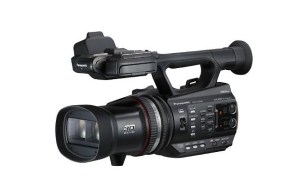
Although 3D technology still hasn’t taken off strongly with consumers, Panasonic is betting that, with just the right gear, everyday photographers and video fans will embrace that technology. To that end, Panasonic has announced its new HDC-Z10000 2D/3D camcorder, and has begun teasing a twin-lens 3D-capable Lumix 3D compact camera, both of which could reach consumers by the end of the year.
First up, the Panasonic Lumix 3D compact camera will be able to shoot 3D photos like a traditional point-and-shoot, but with its twin lenses it will also be able to shot 3D stills and high-definition 3D video. The Lumix 3D gets its small size from two 4× zoom lenses with folded optics and optical image stabilization that operates in 2D, 3D, and video modes. The camera will be able to shoot 2D stills and video at the same time, while the side-by-side lenses will also be able to capture 3D video in AVCHD format. Users can then pop the videos over to their 3D-capable Panasonic Viera TV via an HDMI cable.
Panasonic will be showing the Lumix 3D at the IFA trade show in Berlin this week, but has not announced any pricing information. The Lumix 3D should eb available for sale this winter.
Folks looking for a more robust 3D video solution could check out Panasonic’s upcoming HDC-Z10000 (yes, that’s four zeroes!) 2D/3D video camcorder. With a twin-lens design, Panasonic claims it has the closest 3D video macro setting on the market, able to produce 3D images from as little as 17.8 inches away from a subject—great for animals, small objects, and flowers. Moreover, users won’t have to wear 3D glasses to see their subjects previewed in 3D: The HDC-Z10000’s 3.5-inch LCD viewfinder lens uses a parallax barrier to send slightly different images to the left and right eye, creating a 3D effect—that means videographers can check 3D images while they’re shooting. Of course, the display can toggle between 3D and 2D modes.
The HDC-Z10000 features two 32–320mmm ƒ1.5–2.7 10× optical zoom lenses, optical image stabilization, separate adjustment rings for focus, zoom, and iris, built-in mics that support Dolby Digital 5.1 surround and standard stereo (along with two XLR inputs with phantom power for external mics), dual SD memory card slots, and the ability to shoot 2.1 megapixel stills and shoot 3D still images while recording video.
Panasonic says it’ll announce pricing within 30 days of the HDC-Z10000 hitting the market; expect to see it before the end of the year.
Editors' Recommendations
- Amazon discounts this point and shoot Panasonic Lumix camera by $100
- How to take a 3D photo from almost any smartphone
- The $600 Panasonic Lumix S 20-60mm is a unique, affordable zoom
- This A.I. app converts any photo into 3D, no dual lenses required
- Leica SL2 vs Panasonic Lumix S1R: Two L-mount leaders with one big difference


